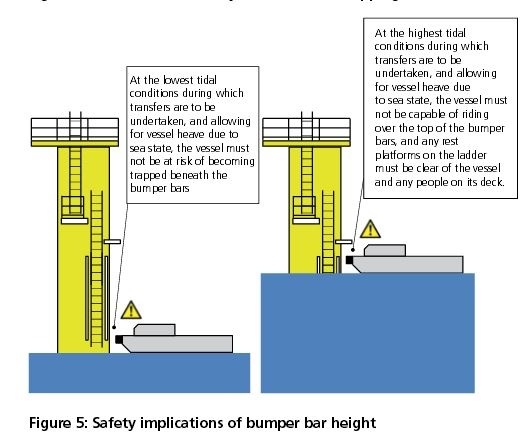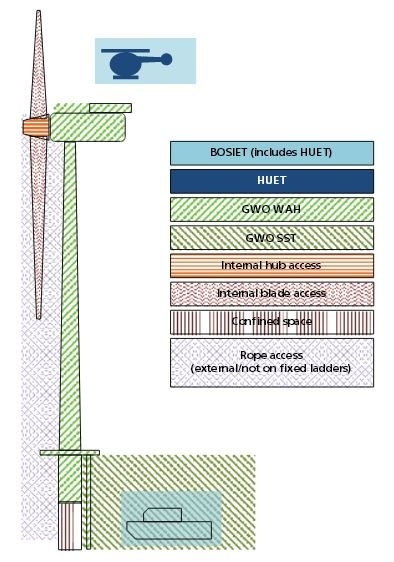Report Excerpt - SgurrEnergy develops "Offshore work at height guidelines to improve offshore practices and techniques"
Leading renewable energy consultancy, SgurrEnergy, in partnership with work at height and rescue specialists, heightec, has developed the good practice guideline ‘Working at height in the offshore wind industry’ for the Energy Institute and G9 Offshore Wind Health and Safety Association.
The guideline, launched at a G9 event in central London on 2nd December, has been developed to reflect the areas of greatest concern in the industry, drawing on incident data, consultations and surveys. The new guideline will be implemented by the G9 members to drive consistency in practices and ways of working across the offshore wind industry.
The scope of work included analysing historical work at height incidents to identify trends and improvements and developing guidance and operational procedures for working at height. The SgurrEnergy and heightec teams also documented requirements for training, skills, fitness, working arrangements and key responsibilities for project managers.
Content Example 1: Safety implications of bumper bar height
Technical Manager at the Offshore Wind at the Energy Institute, Andrew Sykes, said: “This new guideline represents a significant milestone for the G9, and is a deliverable which reinforces the G9 principal aim to demonstrate leadership on HSE issues in the offshore wind industry. The next step will be just as important as G9 members look to implement the key recommendations in relation to working at height contained in this guideline.”
Principal engineer at SgurrEnergy, and co-author of the guidance, David Malcolm, said: “The G9 guideline is a real step forward for the industry, with a group of major developers working together to adopt common approaches and achieve a consistent high standard for work at height across European offshore wind developments.
“This can simultaneously make life easier for people working at height, improve their safety and reduce cost by adopting standard specifications and methods.”
Technical director at heightec, and co-author of the guidance, David Thomas, said: “Working at height is a high risk activity. This guideline is a step forward in disseminating and sharing good practice during the design, construction and operation of wind farm projects.”
Content Example 2: Permitted access zones for different training standards
The G9 and its nine founding members- Centrica, DONG Energy, E.ON, RWE Innogy, Scottish Power Renewables, SSE, Statkraft, Vattenfall and Statoil- are committed to promoting and maintaining the highest possible standards of health and safety throughout the life cycle of offshore wind farms.
For a copy of the Good Practice Guide: Please follow
If you would like to receive our Newsletter or find out more about what w3.windfair.net has to offer, please, do not hesitate to contact Trevor Sievert at ts@windfair.net.
Please don't forget to follow us on Twitter: w3.windfair.net on Twitter
w3.windfair.net is the largest international B2B internet platform in wind energy – ultimately designed for connecting wind energy enthusiasts and companies across the globe.
The scope of work included analysing historical work at height incidents to identify trends and improvements and developing guidance and operational procedures for working at height. The SgurrEnergy and heightec teams also documented requirements for training, skills, fitness, working arrangements and key responsibilities for project managers.
Technical Manager at the Offshore Wind at the Energy Institute, Andrew Sykes, said: “This new guideline represents a significant milestone for the G9, and is a deliverable which reinforces the G9 principal aim to demonstrate leadership on HSE issues in the offshore wind industry. The next step will be just as important as G9 members look to implement the key recommendations in relation to working at height contained in this guideline.”
Principal engineer at SgurrEnergy, and co-author of the guidance, David Malcolm, said: “The G9 guideline is a real step forward for the industry, with a group of major developers working together to adopt common approaches and achieve a consistent high standard for work at height across European offshore wind developments.
“This can simultaneously make life easier for people working at height, improve their safety and reduce cost by adopting standard specifications and methods.”
Technical director at heightec, and co-author of the guidance, David Thomas, said: “Working at height is a high risk activity. This guideline is a step forward in disseminating and sharing good practice during the design, construction and operation of wind farm projects.”
The G9 and its nine founding members- Centrica, DONG Energy, E.ON, RWE Innogy, Scottish Power Renewables, SSE, Statkraft, Vattenfall and Statoil- are committed to promoting and maintaining the highest possible standards of health and safety throughout the life cycle of offshore wind farms.
- See more at: http://www.sgurrenergy.com/sgurrenergy-developed-offshore-work-at-height-guidelines-to-improve-offshore-practices-and-techniques/#sthash.0DlwHPe3.dpufThe scope of work included analysing historical work at height incidents to identify trends and improvements and developing guidance and operational procedures for working at height. The SgurrEnergy and heightec teams also documented requirements for training, skills, fitness, working arrangements and key responsibilities for project managers.
Technical Manager at the Offshore Wind at the Energy Institute, Andrew Sykes, said: “This new guideline represents a significant milestone for the G9, and is a deliverable which reinforces the G9 principal aim to demonstrate leadership on HSE issues in the offshore wind industry. The next step will be just as important as G9 members look to implement the key recommendations in relation to working at height contained in this guideline.”
Principal engineer at SgurrEnergy, and co-author of the guidance, David Malcolm, said: “The G9 guideline is a real step forward for the industry, with a group of major developers working together to adopt common approaches and achieve a consistent high standard for work at height across European offshore wind developments.
“This can simultaneously make life easier for people working at height, improve their safety and reduce cost by adopting standard specifications and methods.”
Technical director at heightec, and co-author of the guidance, David Thomas, said: “Working at height is a high risk activity. This guideline is a step forward in disseminating and sharing good practice during the design, construction and operation of wind farm projects.”
The G9 and its nine founding members- Centrica, DONG Energy, E.ON, RWE Innogy, Scottish Power Renewables, SSE, Statkraft, Vattenfall and Statoil- are committed to promoting and maintaining the highest possible standards of health and safety throughout the life cycle of offshore wind farms.
- See more at: http://www.sgurrenergy.com/sgurrenergy-developed-offshore-work-at-height-guidelines-to-improve-offshore-practices-and-techniques/#sthash.0DlwHPe3.dpufThe scope of work included analysing historical work at height incidents to identify trends and improvements and developing guidance and operational procedures for working at height. The SgurrEnergy and heightec teams also documented requirements for training, skills, fitness, working arrangements and key responsibilities for project managers.
Technical Manager at the Offshore Wind at the Energy Institute, Andrew Sykes, said: “This new guideline represents a significant milestone for the G9, and is a deliverable which reinforces the G9 principal aim to demonstrate leadership on HSE issues in the offshore wind industry. The next step will be just as important as G9 members look to implement the key recommendations in relation to working at height contained in this guideline.”
Principal engineer at SgurrEnergy, and co-author of the guidance, David Malcolm, said: “The G9 guideline is a real step forward for the industry, with a group of major developers working together to adopt common approaches and achieve a consistent high standard for work at height across European offshore wind developments.
“This can simultaneously make life easier for people working at height, improve their safety and reduce cost by adopting standard specifications and methods.”
Technical director at heightec, and co-author of the guidance, David Thomas, said: “Working at height is a high risk activity. This guideline is a step forward in disseminating and sharing good practice during the design, construction and operation of wind farm projects.”
The G9 and its nine founding members- Centrica, DONG Energy, E.ON, RWE Innogy, Scottish Power Renewables, SSE, Statkraft, Vattenfall and Statoil- are committed to promoting and maintaining the highest possible standards of health and safety throughout the life cycle of offshore wind farms.
- See more at: http://www.sgurrenergy.com/sgurrenergy-developed-offshore-work-at-height-guidelines-to-improve-offshore-practices-and-techniques/#sthash.0DlwHPe3.dpuf- Source:
- SgurrEnergy
- Author:
- Edited by Trevor Sievert, Online Editorial Journalist / by SgurrEnergy Staff
- Email:
- ts@windfair.net
- Link:
- w3.windfair.net/...


